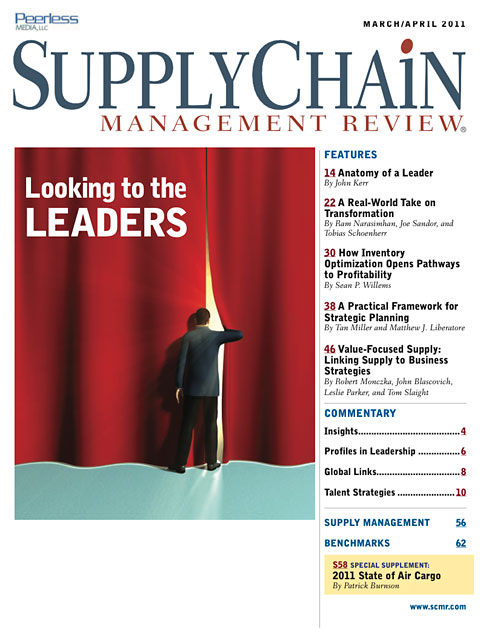Sorry, but your login has failed. Please recheck your login information and resubmit. If your subscription has expired, renew here.
March-April 2011
Leadership is one of the most popular topics we write about in SCMR. We all seem to be fascinated by individuals who can rally a company, a sports team, a country toward a shared goal. Yet when asked just what makes a good leader, most of us struggle with a precise answer. It's kind of: "Well I know what real leadership is when I see it." Reflecting our leadership theme this issue, we're pleased to introduce a new section of the magazine called "Talent Strategies." It's written by the experts at MIT's Center for Transportation & Logistics, which has both a depth of research and hands-on experience in… Browse this issue archive.Need Help? Contact customer service 847-559-7581 More options
Over the past two decades, companies worldwide have saved hundreds of billions of dollars by aggressively applying competitive sourcing techniques to their spend base. Companies gained control over 50, 60 or even 70 percent of their revenue that flowed to suppliers. Information technology enabled companies to gain visibility into what they were spending, where and with which suppliers.
By spend aggregation across business units and geographies and concentrating spend with fewer suppliers, companies established leverage they never realized they had. Standardized approaches to sourcing brought rigor and discipline to both fact-finding and analysis. E-tools enhanced competition, improved decision-making, and sped up sourcing processes.
Looking back over the past 20 years, it is clear that competitive sourcing created significant value for companies by driving major cost savings directly to the bottom line. However, A.T. Kearney’s 2008 Assessment of Excellence in Procurement (AEP) global research found that the savings gap between “leader” and “follower” companies had shrunk by half just since 2004. Continued attention to competitive sourcing will remain necessary just to keep up…
In this environment, just saving money on external expenditures will not be enough to survive, let alone thrive, in the years to come. Companies must find and obtain additional value from their supply relationships. The supply network needs to contribute holistically to the company via innovation and growth, asset utilization, sustainability, risk management and overall competitiveness as well as cost.
These new, more advanced Value Focused Supply (VFS) strategies are the target of this article.
 |
This complete article is available to subscribers
only. Click on Log In Now at the top of this article for full access. Or, Start your PLUS+ subscription for instant access. |
Not ready to subscribe, but need this article?
Buy the complete article now. Only $20.00. Instant PDF Download.
Access the complete issue of Supply Chain Management Review magazine featuring
this article including every word, chart and table exactly as it appeared in the magazine.
SC
MR
Sorry, but your login has failed. Please recheck your login information and resubmit. If your subscription has expired, renew here.
March-April 2011
Leadership is one of the most popular topics we write about in SCMR. We all seem to be fascinated by individuals who can rally a company, a sports team, a country toward a shared goal. Yet when asked just what makes a… Browse this issue archive. Download a PDF file of the March-April 2011 issue.
 |
Download Article PDF |
Over the past two decades, companies worldwide have saved hundreds of billions of dollars by aggressively applying competitive sourcing techniques to their spend base. Companies gained control over 50, 60 or even 70 percent of their revenue that flowed to suppliers. Information technology enabled companies to gain visibility into what they were spending, where and with which suppliers.
By spend aggregation across business units and geographies and concentrating spend with fewer suppliers, companies established leverage they never realized they had. Standardized approaches to sourcing brought rigor and discipline to both fact-finding and analysis. E-tools enhanced competition, improved decision-making, and sped up sourcing processes.
Looking back over the past 20 years, it is clear that competitive sourcing created significant value for companies by driving major cost savings directly to the bottom line. However, A.T. Kearney’s 2008 Assessment of Excellence in Procurement (AEP) global research found that the savings gap between “leader” and “follower” companies had shrunk by half just since 2004. Continued attention to competitive sourcing will remain necessary just to keep up…
In this environment, just saving money on external expenditures will not be enough to survive, let alone thrive, in the years to come. Companies must find and obtain additional value from their supply relationships. The supply network needs to contribute holistically to the company via innovation and growth, asset utilization, sustainability, risk management and overall competitiveness as well as cost.
These new, more advanced Value Focused Supply (VFS) strategies are the target of this article.
 |
SUBSCRIBERS: Click here to download PDF of the full article. |
SC
MR

Latest Supply Chain News
- Retail sales see gains in October, reports Commerce and NRF
- Balancing green and speed: Home delivery insights from the pandemic era
- AdventHealth named top healthcare supply chain by Gartner
- Geopolitical readiness in supply chains: Strategic challenges for leaders
- Unlocking retention: The role employee engagement plays
- More News
Latest Podcast

 Explore
Explore
Latest Supply Chain News
- Retail sales see gains in October, reports Commerce and NRF
- Balancing green and speed: Home delivery insights from the pandemic era
- AdventHealth named top healthcare supply chain by Gartner
- Geopolitical readiness in supply chains: Strategic challenges for leaders
- Unlocking retention: The role employee engagement plays
- Can supply chain managers embrace an entrepreneurial mindset?
- More latest news
Latest Resources

Subscribe

Supply Chain Management Review delivers the best industry content.

Editors’ Picks





